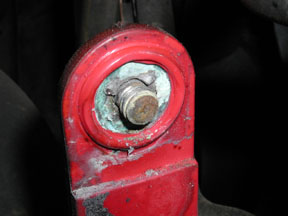
You get into the family buggy and try to start it. It cranks over but sounds like it is cranking slowly. After a few seconds of cranking it still turns over, but slowly. Before you go out and buy a new battery, read this. Maybe you will eventually buy a new battery, but you will have diagnosed the problem and will not be wasting your hard earned cash..
The things we are going to check out here are a bad battery, corroded cables or a bad starter motor. A bad battery will be detected by a low voltage at the battery terminals (not the cables) while cranking. Corroded cable connections will be detected by low voltage at the cable ends. A bad starter motor will draw a high current and the battery cables will get warm to the touch.
You have to get inside the ends of these new fangled side terminal battery cable ends to make sure they are free of corrosion. Just brushing them with a wire brush is not sufficient!! Believe me!! Remove the battery cables from the battery and clean them thoroughly by dipping the ends in a paper cup full of water with two tablespoons of bicarbonate of soda mixed in. Brush the battery terminals and cable ends with a wire brush and keep dipping them in the cup until all the green corrosion is gone.

Rinse the cable ends with clean water and reassemble them, positive first.
If you want to do a little bit of diagnostics either before or after cleaning the cables (assuming that cleaning them didn't fix the problem) then do the following. The first thing you have to do is to make sure that the battery is fully charged. Put a charger on it for at least three hours. Now, get yourself a voltmeter and start measuring voltages. First across the battery terminals. Should be a good solid 12 volts from your battery, 14.5 if you have the jumpers connected to a running car. A battery that is three or four years old will probably cause you problems, either now or some night when it's 20 below zero!! Replace it!
Now try to start it. While it's cranking measure the voltages across the battery terminals. It should be somewhere around 12 volts or just below. If it is much lower than that, say 10 volts, then the battery is bad and should be replaced. If it is around 12 volts then leave the negative voltmeter lead on the battery and probe the starter. The voltage there should be 12 volts or so, not much lower. If it still hasn't started and the battery runs down again then feel the cables to the starter - are they hot? If so then the starter motor may be shot and is drawing too much current. If you can get a clamp-on ammeter then use it to measure the current draw of the starter motor. 300 amps is typical - 400 means that the armature is dragging on the stator and drawing too much current.
Back to Brother Bob's Home Page
Copyright © 1996, 1997, 1998, 1999, 2000, 2001, 2002 by Bob Hewitt - All rights reserved